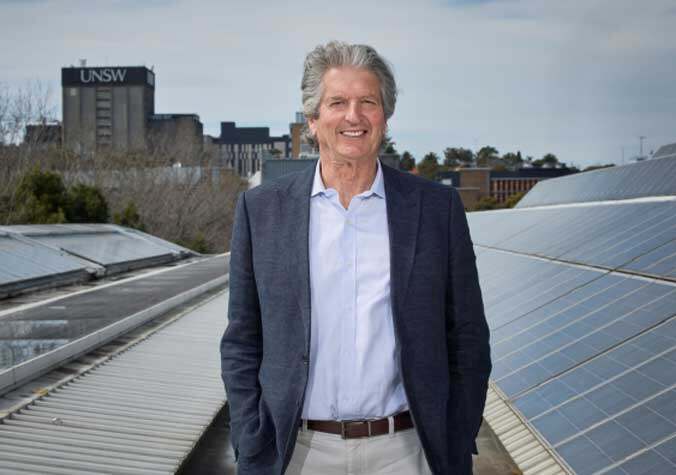In his second international accolade in as many days, Scientia Professor Martin Green has been awarded the VinFuture Grand Prize in Hanoi for his transformational work in solar energy.


UNSW Sydney’s Scientia Professor Martin Green has won the VinFuture Grand Prize for his pioneering research and leadership in global solar energy.
He shares the $US3 million prize money equally with the team of scientists responsible for developing the lithium-ion battery, Professor Stanley Whittingham from Binghamton University in the United States, Professor Rachid Yazami from the Nanyang Technological University in Singapore and Dr Akira Yoshino from the Asahi Kasei Corporation in Japan. The four were presented with their awards at a ceremony in Hanoi, Vietnam tonight.
The VinFuture Grand Prize is the first major scientific prize based in Asia Pacific. The Prize is awarded for breakthrough research and technological innovations that improve people’s quality of life and create a more equitable and sustainable world for future generations.
Two of this year’s other winners who are sharing the prize with Prof. Green, Prof. Whittingham and Dr. Yoshino, won the 2019 Nobel Prize in Chemistry. Winners of the inaugural 2021 VinFuture Grand Prize, Katalin Karikó and Drew Weissman, went on to win this year’s Nobel Prize in Medicine for their discoveries that enabled the development of effective mRNA vaccines against COVID-19.
Prof. Green is a world-leading specialist in silicon solar cells, and the research group he founded at UNSW is the largest and best-known university-based photovoltaic research group in the world.
He led the team that invented and perfected the Passivated Emitter and Rear Contact (PERC) solar cell and the team that first demonstrated the Tunnel Oxide Passivated Contact (TOPCon) cells. Together, these cells account for more than 90 per cent of solar cells manufactured in the world today. He’s also trained more than 120 PhD students, many of whom have been responsible for establishing large-scale solar cell manufacturing in China, building the global industry and being pivotal in dramatically lowering the costs of solar energy.
Solar a critical enabler for decarbonisation
UNSW’s Acting Vice-Chancellor and President Professor George Williams said he is delighted that Prof. Green’s accomplishments have been recognised with the VinFuture Grand Prize, and that without him the modern solar industry would not exist.
“Thanks to the innovations and advances in photovoltaic technology developed by Martin and teams at UNSW, solar energy is a viable and critical enabler in the global transition to renewable energy and decarbonisation,” Prof. Williams said.
“The enormous reductions in costs in photovoltaic solar systems in recent years are directly related to his scientific efforts, largely through the work of his students in establishing manufacturing centres in Asia via Australian-Asian joint ventures.
“On behalf of everyone at UNSW – our students, staff and community – we wholeheartedly congratulate you, Martin, on being awarded the VinFuture Grand Prize.”
Prof. Green said he’s honoured to receive the VinFuture Prize due to its growing prominence in celebrating scientific inventions that are solving some of the world’s most pressing challenges, particularly in developing countries.
“It’s a privilege to be awarded the VinFuture Grand Prize in such esteemed company. I wish to thank the many other researchers – not only in my lab and but also from around the world – who have helped make solar photovoltaics a viable option for enabling the transition from fossil fuels to a sustainable energy future.
“I particularly want to acknowledge both Mr Pham Nhat Vuong and Madam Pham Thu Huong for founding the VinFuture Foundation and the VinFuture Prize, recognising those creating positive change in the lives of people through science and technology.
“Finally, I would like to thank my wife, Judy Green, my own renewable resource, for her ongoing support right from the start of my career in solar.”
New solar technology research
Despite his lifetime of achievements, which include the Japan Prize, Millennium Technology Prize, Global Energy Prize and the Queen Elizabeth Prize for Engineering, Prof. Green has no intention of resting on his laurels (or laureates). He’s convinced that the ultimate solar technology is still to come, and he’s determined to make it a reality.
“We were first to estimate the limit of a silicon cell efficiency to be 29-30 per cent. Silicon cells are very good at converting red photons from sunlight, but not so efficient at converting blue ones, since they waste a lot of their energy. So we’re working on stacking cells on top of each other, which would work in tandem to convert different parts of the solar spectrum into electricity. We believe this innovation could boost commercial cell efficiency to over 40 per cent in future,” Prof. Green said.
“To realise the dream of a truly sustainable global energy system, built off the back of notebook-sized solar cells, would be to truly be able to say that Australian technology had helped change the world.”






































